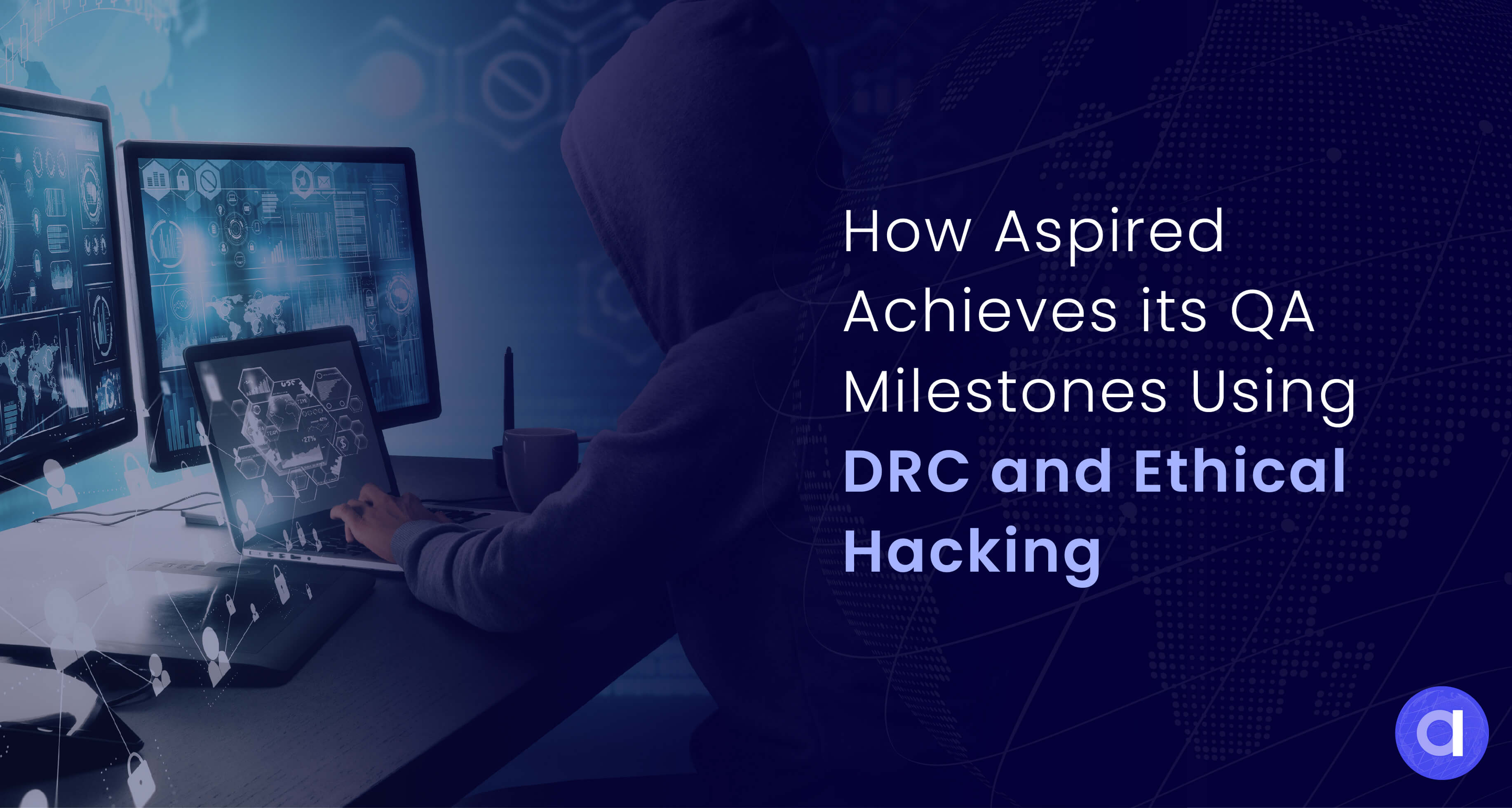As the great Alexander Pope said; “To err is human, to forgive divine. Unfortunately, in this day and age, human errors can be costly and rarely forgiven, especially when working on a high-stakes product. This is why we at Aspired don’t settle for anything below ‘Exceptional’. With Years of experience in helping businesses find the right remote resources and contributing to their continued success by generating lasting value through our development lifecycle has enabled Aspired to design unmatched success-driven frameworks.
We understand that without a robust quality assurance ecosystem in place, no software development enterprise can consistency deliver near-flawless products & exceed client expectations. They say nothing gives a developer a black eye more than a bug-filled release requiring constant patches and upgrades, and we cannot agree more.
Aspired for Quality
Aspired prioritizes quality over anything. We know customers out there aren’t looking for another app that does the same thing but rather they are seeking "quality" solutions for their problems. Therefore, we have created a QA ecosystem that enables our team to produce unrivaled quality work while staying consistent with the project timelines.
But what's Aspired's secret recipe to achieving complete QA milestones without dragging out the project timeframes? Well, there is no magic spell. Our secret to 99.7% successful project completion is our commitment to quality. We believe in designing systems and defining procedures that are responsible for consistent throughput of high-quality solutions.
A part of it includes our success-driven framework that comprises our Design Review Committee (DRC) along with a team of Ethical Hackers that act as QA milestones for our projects and provide valuable optimization insights that contribute to a project's prolonged success.
Let's deep dive into all the steps that come into play for bringing Aspired's promise of top-quality software solutions into reality:
Our Approach to Sustainable Quality
Aspired's quality assurance approach goes beyond the 'doing everything the right way' tactic. Instead, our qualified expertise is more invested in creating software solutions that resonate with the client's idea and add value to the user's lives.
The idea is to cover all the implicit and explicit expectations to ensure the highest degree of compliance with quality standards. To make it happen, we have divided our quality assurance into two main categories;
- Functional – the product's compliance with functional (front-end) requirements and design specifications (UI/UX). This phase of software QA focuses on how it is really used by the user, including its performance, usability, and lack of bugs.
- Non-Functional – the products' inner characteristics, code base, and architecture, i.e., structural (back-end) requirements. This covers the efficiency, maintainability, and above all, the security of the code.
Phase # 01: DRC – Design Review Committee
What is a DRC?
DRC, commonly known as Design Review Committee, is the most significant part of our QA ecosystem. It is an arrangement that allows our team of experts (product owners, subject matter experts, designers, business analysts, quality assurance leads, and at times marketing Experts) to put their heads together to work out a Pitch Perfect design and artwork that truly resonates with the target app audience.
The team pins down current design trends and pair them with your requirement through very eccentric research in place to address and finalize the design and artwork aspect of the application.
Who is part of the DRC?
Generally, a DRC comprises Graphic artists, designers, app/game junkies, product strategists, business analysts & QA leads. In more complex product, subject matter experts and solution architects may also be called upon. The aim is to do a first-hand expert overview with a focus on nailing down the overall system design of the project.
This phase addresses everything that is even remotely design-relevant, from the application's logo to the interfaces, from the design screens to the transitions and the dynamic animations across all interfaces, including aspects of system & architectural design. This interface, along with all its controls and dynamics, is assessed multiple times before putting forward the consented version.
DRC is our standard protocol, which is in place to ensure that we cover all the crucial elements and don't take the easy way out by making hasty and outdated designs and artwork.
Step # 1: End User Review of UI/UX
The first step of our QA process begins when our Design Review Committee takes on the developed software to do a preliminary overview of the UI/UX, purely from a user's point of view. Next, the team thoroughly inspects all the features included in the given product to find whether it serves its predefined 'purpose' behind it. Also, how easy or difficult is this software to use from a non-technical user point of view?
This main goal of this tep's is to ensure the software product achieves the customer objectives, aligns with the main purpose of development, and achieves all the ticks for usability, desirability, and accessibility. Here are the some of the elements our Design Review Committee aims to analyze during this step:
- Determine whether or not the product completely serves its purpose
- Does the product offer expect levels of UI/UX?
- What is the ease of using this product, and what is its expected performance in terms of its design?
Are there any glitches or notable complications that affect the use of this product? Note: If the product fails to achieve a total consensus of the team on its purpose achievement and general feasibility, it goes back to the development process upon the client's call, subject to the timeframe flexibility.
Step # 2: Comparing with Predefined Scope
After the product goes through preliminary testing, it is time for our team to put their developer hat on. Until this, the product's general viability and purpose are achieved. Then, it is time to begin the technical evaluation of whether the product completely aligns with the predefined scope.
The practice of setting up the project scope clearly enough is valuable as it proves to be a blueprint to guide the progress of the project and help our QA team to assess deviations (if any) from the goals for the project. Following are the parameters our team compares the scope for:
- Deliverables: The technical (UI/UX) and non-technical (ease of use) outcomes of the project are defined during the discovery phases, before the development process kicks off. The team makes sure the product is equipped with all the deliverables. Moreover, all the prespecified KPIs come into play to see whether the product is specifically tailored to the client's needs.
- Project Vision: Ensuring the product reflects the project vision is one way of achieving success. It is achieved by answering questions like what is this software product's strategic goal? What issue(s) does it aim to solve? Compared to its competitors' products, what innovative edge does it carry? Does it fulfill the success parameters predefined for it?
- Implicit Requirements: The implicit or functional requirements, as per the scope of the project, define how this product will interact with its users. Anything and everything that adds to the user experience and provides a solution to the 'very' problem this product is designed for is checked.
- Explicit Requirements: The explicit or non-functional requirements include defining how the system will operate, its user-friendliness, adaptability, speed, and utility. The team makes sure the product's quality will remain high when it reaches a wider audience.
Note: It is okay to find one or more things that diverge from the project scope at this stage. The aim is to make the quality assurance process efficient and transparent to allow the client to decide to what extent of perfection they wish to achieve the project goals.
Step # 3: Best Practices in the Market
Once the software product has successfully been through the first two evaluation steps, it is almost ready to launch. However, a complete software product doesn't always mean a successful software project. The difference between the two is which one is up-to-date, uses the latest technology, and capitalizes on the best practices in the market.
Our design review committee knows the importance of incorporating the best practices in a project very well. Furthermore, they understand that most of the best practices prevailing in the software development industry result from trial and error and are thus found to be the most sensible way to proceed.
Example: iPhones do not come with a dedicated 'Back button. Imagine using a banking app; you are done with making your transaction, watching the bank statement, and adding the beneficiary. You want to go to the homepage, but the back slide will only take you to the previous tab. The best practice, in this case, is to provide a back button in the app that ensures smoother navigation.
Step # 4: Aligning with Market Trends
Aspired is aware of how important it is to stay current with the market trends in this face-paced industry. Therefore, a forward-looking development strategy includes being on top of the market trends and incorporating everything in the software product that helps it stand out from the crowd.
In the final step of our DRC, our committee members are tasked with comparing the final product with the market trends and look for the right technical additions in order to align the product with the latest market trends. The idea is to stand one step ahead of the technology transition and not lag due to 'soon-to-be-outdated' decisions.
Example: When Instagram introduced the double touch tap for like option, Facebook took little time to adopt it. Similarly. YouTube’s double-to-fast forward was a go-to thing for Netflix. These two and many more examples of how market trends, if followed at the right time, can bring great results.
Report Generation
As soon as all the above steps are done and dusted, our committee releases a thorough DRC report that states a detailed assessment of the software project's technical, non-technical, and technological aspects.
More importantly, it includes all the major and minor changes proposed by the team that could be subjected to revision. The DRC report gives the client a clear perspective of where the project stands in terms of the set standards and allows them to make an informed decision on which direction they wish to proceed with.
There are common points of the DRC report are:
- Test case execution of the project is 100 percent complete.
- The software project has no high-priority/system defects.
- The performance of the software is stable, along with all its design features.
- The software supports all obligatory platforms and browsers
- User acceptance testing is accomplished.
- All the major and minor changes/improvements have been highlighted, along with the expected time allocation.
Phase # 02: Ethical Hacking:
Not many like to talk about this, but Aspired does. The 2nd QA milestone looks to our ethical hackers, who are deployed to assess the project from a more technical aspect searching for vulnerabilities in the codebase and/or infrastructure. Our ethical hackers allow us to reach the highest levels of security, standardization, and functionality in our software solutions by testing them in extreme situations.
The Need
Security testing holds significant importance in any development process as disregarding this vital check can leave your software more vulnerable to threats and attackes. Since you cannot afford to rely on the “But the development team has already checked the code” approach. An in-house ethical hacking setup can conduct security testing efficiently and successfully cutting down time and energy required in the long-term QA cycle of the project, not to mention inherently optimizing the health of the codebase.
Moreover, a consistent ethical hacking practice also leads to the development of tools and SOPs to expose the most prominent and recurring errors. This approach enables a development team to adopt a proactive approach and perform error-free coding.
The Goal
The idea is to check the network's architectural and programmed strengths to stand the security breaches while exposing the potential vulnerabilities in the system that could be exploited later. The most typical flaws that ethical hackers have found include injection attacks, broken authentication, security misconfigurations, the use of components with known vulnerabilities, and sensitive data exposure.
This marks the end of our Quality Assurance Protocol. The client and our remote developer's team have now developed a clear idea of how much the project needs to be polished and sharpened before the launch, provided the timeline allows it.
Wrapping Up
Aspired believes in the proactive approach of doing things better, and our QA ecosystem is a sound reflection of that approach. Since it is an ongoing process, our developers and software engineers continue to strive until the ultimate quality standards are achieved while keeping an eye on the deadline.
Going hard on each and every step of our product development and design process allows us to gauge the final software product from all directions, along with preventing any defects. No wonder, Aspired is known for its top-notch quality development solutions that are not just designed on the latest technologies but also reach true market heights within no time. For any queries about our processes, feel free to contact us at Aspired.io.

 Clients
Clients
 Processes
Processes
 Blog
Blog










